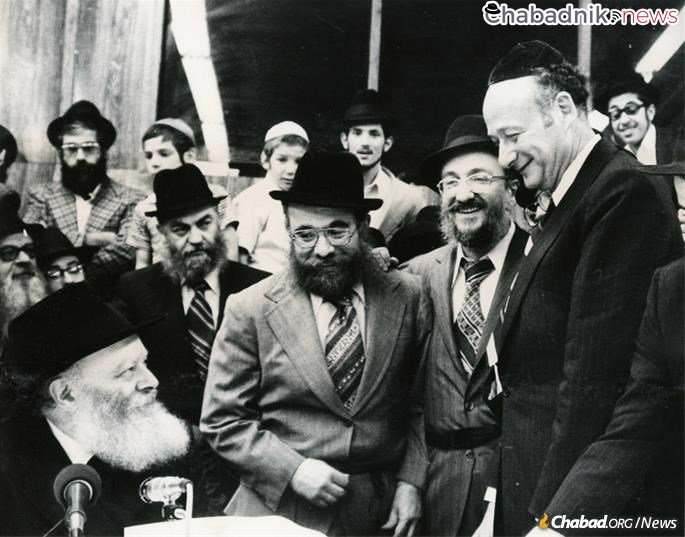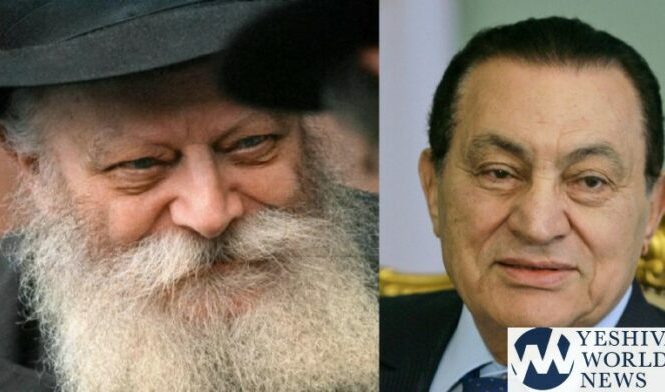On the 30th anniversary of the riots, how Crown Heights survived to remain a thriving Jewish neighborhood
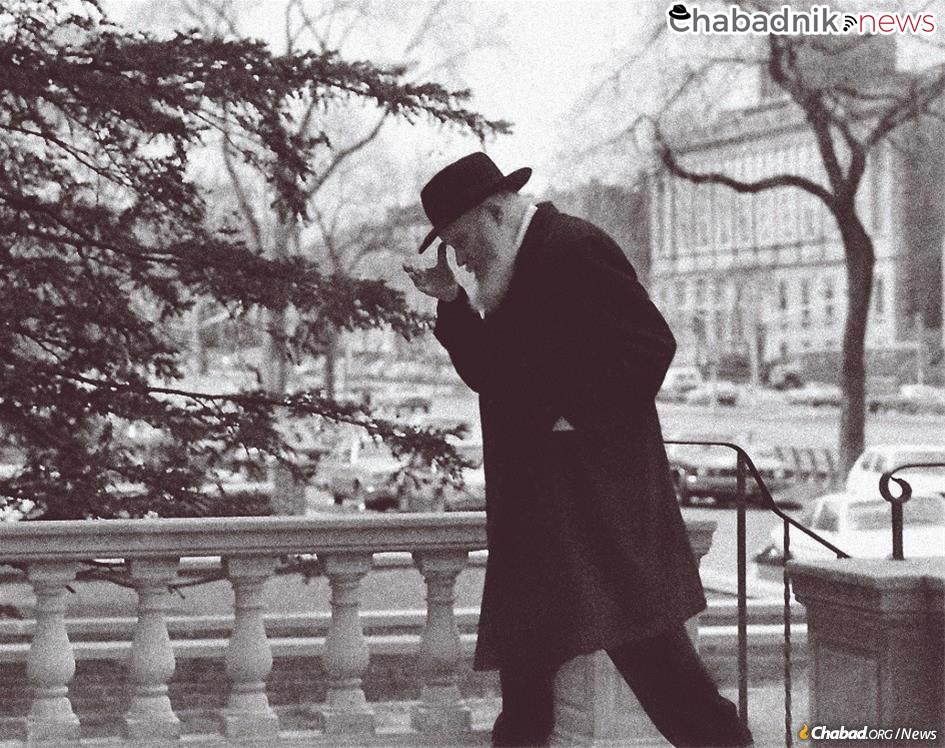
The Crown Heights Riot took place 30 years ago this month. The event, three days of unrestrained anti-Semitic violence, resulted in the stabbing murder of one Jew, Yankel Rosenbaum, the death by suicide of an elderly Holocaust survivor, and, in the words of historian Edward Shapiro, “the most serious anti-Semitic incident in American history.” The horror of New York City’s inaction in quelling the violence and the resulting miscarriage of justice was only compounded by the activists, members of the media and government officials who used the accidental death of Gavin Cato, tragically hit by a Jewish driver who had lost control of his car, to blame “both sides” for the rioting.
Writing in his autobiography five years after the riot, Al Sharpton, whose incendiary rhetoric during the event helped perpetuate the violence and who has never expressed regret for his incitement during the rampage, described the Jewish community of Crown Heights as a “Fort Apache in the black ghetto, [and] a hot-and-cold irritant to their neighbors.” The implication of these words was clear: it was true that Crown Heights had once been a Jewish neighborhood, but that was all in the distant past. How dare they remain once circumstances had altered the neighborhood’s makeup?
Shapiro, in his study Crown Heights: Blacks, Jews and the 1991 Brooklyn Riot, cites a local Crown Heights pastor calling Jews purchasing homes in the neighborhood “an aggressive Zionist expansionist policy.” That Jews still somehow lived side-by-side with their black neighbors in Crown Heights was not laudatory, not even merely curious, but nefarious. These Jews ought to have run when the rest of them did. Wasn’t that the way it was supposed to work?
True, by 1991 the Jews were concentrated in a far smaller geographic area than decades earlier. Similarly, whereas Crown Heights had once contained a cross section of Jewry, the majority of those who had remained in Crown Heights were Lubavitcher Chassidim. Nevertheless, the fact remained: The Jewish community still existed and was even growing, unlike the disappeared Jewish communities of Brooklyn’s Brownsville, East New York, East Flatbush, vast swaths of the Bronx and Queens, and old urban neighborhoods throughout the United States from Boston to Cleveland, and Philadelphia to Chicago.
What indeed were the Jews still doing in Crown Heights?
The answer, of course, was the Rebbe, Rabbi Menachem M. Schneerson, of righteous memory. In the face of an overwhelming tide of inner-city violence and destabilizing social collapse, in the spring of 1969, the Rebbe announced publicly that he was not leaving Crown Heights, explaining that Jewish law expressly forbade the abandonment of a Jewish community. In light of rumors that he, too, would soon follow other Jewish leaders and flee with his community further south into Brooklyn, he was making his opinion clear for one and all: Jews have no right to flee and weaken the community, placing at risk those who remained, especially the poor, elderly and infirm. More, their capitulation would destabilize other Jewish neighborhoods in Brooklyn, the country, and ultimately, anywhere in the world where Jews might live.
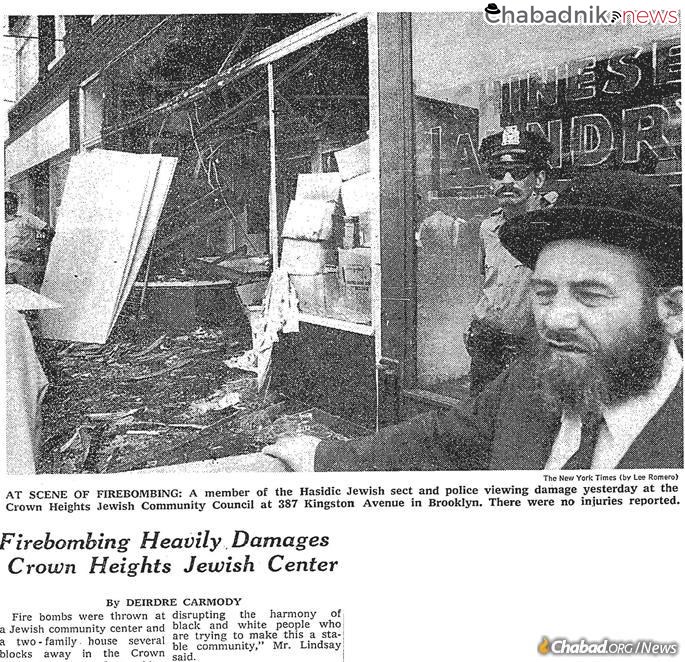
This sharp talk, in which the Rebbe referred to the panicked abandonment of Jewish communities as “a plague,” was delivered on the last day of Passover, April 10, 1969. Though this was the Rebbe’s first public pronouncement on the topic, he had long been working to stabilize Crown Heights. Some of these efforts can be gleaned from a recording of a meeting held six months earlier between the Rebbe and New York Mayor John Lindsay in the Rebbe’s office at Chabad-Lubavitch headquarters, 770 Eastern Parkway in Crown Heights. In the meeting, Lindsay pledges support for the Rebbe’s “efforts to keep the community together and to keep it stable. You’ve been doing a wonderful job on that, and given great leadership to your people.”
“I’m trying to expand it,” the Rebbe replies, “but it can be done only if it’s in a peaceful atmosphere apart from external complications.”
Lindsay was there to pledge his administration’s support for the Rebbe’s stabilization efforts, including security and policing. “I’m very concerned about Crown Heights,” he told the Rebbe, “because it is very key to the whole community of Brooklyn.”
“It is a test case,” the Rebbe responded. “ … Not only for New York,” but for the rest of the country and “the world in general.”
By confronting the problem of community flight in Crown Heights in a way that did not callously dismiss the needs of the neighborhood’s long-standing Jewish population, New York had the opportunity to serve as a model for the world. Crown Heights would indeed be the test case—the place where the unstoppable forces of massive social change and social engineering would meet the immovable object of the Rebbe’s conviction that Jews should not, and could not, be chased out of their neighborhoods.

Thirty years after the riots and more than 50 years since the Rebbe took his stand, Jewish Crown Heights not only survives, but thrives. Across the street from 770, on the site of what was once a condemned building, stands the modern Jewish Children’s Museum. Yeshivah school buses snake along the streets in the morning and afternoon taking thousands of Jewish children to and from school. The neighborhood has long since grown out of its artificial borders, and members of the Crown Heights community today live far north of Eastern Parkway and deep south into what is technically East Flatbush. There are more than 85 synagogues serving a wide spectrum of people, including those with special needs. Crown Heights has in the last decades become so safe that many young Jews, some of them even the grandchildren of those who years ago fled Crown Heights or other parts of Brooklyn for the suburbs, have once again made the neighborhood home.
If once upon a time Crown Heights’ problem was too many vacant homes and too few Jews to maintain them, the area now suffers the exact opposite: too little housing, especially affordable housing, for its burgeoning population. There was a time, not too long ago, when no one would have believed this would ever be the case.
Displacement
The 1960s were a time of widespread, earth-shattering social and cultural change—some of it positive, some of it less so. More than half a century later, the ’60s continue to hold a grasp on American collective memory and in many ways still shapes its wider culture. Less remembered about that mythic decade, though, is the fact that in those few years, the vast majority of urban American Jewish communities simply vanished, some practically overnight.
The tragic phenomenon is not very often acknowledged, and when it is, it’s typically swept under the rubric of “suburbanization” or the less benign “white flight.” This ignores the vast trauma inflicted on Jews, most of them first- or second-generation refugees, who had spent decades building their lives in what they thought were secure neighborhoods only to have the ground give way from under their feet. Go to the old Jewish neighborhoods these days, and you can still see haunting signs of their former inhabitants. A Star of David here, a granite cornerstone with the Jewish year on it there. A menorah, the Ten Commandments, an inscription; “Open the Gates of Heaven!” the abandoned Hebrew words cry.
It was a combination of factors that pushed Jews out of their neighborhoods in city after city across the United States. The 1950s had seen the construction of the Eisenhower interstate highway system and the boom of leafy suburbs. The vast majority of Jews were still living in urban neighborhoods, but many began leaving of their own volition for life in the greener pastures of, in New York City’s case, Westchester County, Long Island and northern New Jersey. This was especially the case for upwardly mobile Jews leaving poorer and more crowded neighborhoods. But it wasn’t all that simple. Some Jews—men and women who had purchased homes, paid off their mortgages, built businesses, synagogues, schools and social networks—had no desire for the new suburban life out there. Unfortunately, the years of skyrocketing crime rates, ineffectual policing, misguided social policy and the efforts of those who sought to instigate and profit from their flight, compounded by intergenerational trauma and fear, made remaining in place feel all but impossible for most.
They “simply saw the whole thing as hopeless,” the late Pete Hamill wrote about those who fled Brooklyn in a 1969 cover story for New York magazine. “Brooklyn, which in their youth had been the city of trees and free spaces and security, was being torn apart by drugs and gang wars. … Take the money and get out while you can. There was racial fear involved, of course, but it would be too easy to explain it all away that way. It was race plus despair plus insecurity about money plus desires for the betterment of one’s children plus—the most important plus—the loss of a feeling of community.”
What happened to these American urban Jewish communities was tremendously sad, but it was not new. In one way or the other, Jews had been on the run since the destruction of the Second Temple in Jerusalem nearly 2,000 years earlier. From ancient Alexandria to medieval Spain, North Africa, the former Communist Bloc and Western Europe, remains of Jewish communities abound.
It had always been the case that during times of great stress, Jews would be forced to leave their communities and rebuild elsewhere. In this context, what happened to American Jewish communities in the 1960s was no different. They may not have been summarily expelled, but the collapse of their communities was by no means unprecedented in the greater picture.
“A wide range of public policies made sustaining these communities difficult,” says Howard Husock, a senior fellow at the American Enterprise Institute and a contributing editor at City Journal. “Jews and Jewish neighborhoods became collateral damage. This didn’t happen to the Italians and the Irish in the same way: Jews were the most upwardly mobile, the most liberal in terms of welcoming and renting to blacks, and ultimately the most fearful” when crime rates began spiking.
It was only the Rebbe who would insist that Jews had the right to remain in their homes and among their people in peace and tranquility, no matter what. “Lubavitch came along and took a stand,” observes Husock. “They said, ‘We’re not fearful.’ ”
The Rebbe maintained that it was not right that one population (in this case, the Jewish one) should be forcibly displaced by another, but he always made clear that it had nothing to do with race.
“You must tell your mother that she has no need to panic from the fact that a colored family moved in nearby,” the Rebbe wrote to a Jewish family expressing worry about their new neighbors. “They, too, are people with whom one can share a neighborhood. On the contrary: there are white people who are not of the best nature, too … .”
It would take effort, determination and planning to accomplish this, but the Jews of Crown Heights, the Rebbe said, had an obligation to their brethren nearby and around the world to prove it was possible.

The Alrightniks
When the Sixth Rebbe, Rabbi Yosef Yitzchak Schneersohn, of righteous memory, arrived in New York City from Nazi-occupied Europe in the spring of 1940, a committee of Chabad-Lubavitch Chassidim and supporters was formed to search for a residence and synagogue where he could make his new base in the United States. The Sixth Rebbe, who used a wheelchair due to health problems, some stemming from his harsh treatment in Soviet imprisonment, required an elevator in particular. Soon, a suitable structure was found to be for sale at 770 Eastern Parkway in Brooklyn’s Crown Heights neighborhood; Lubavitch closed on the distinctive neo-Gothic structure on Aug. 16, 1940, and Rabbi Yosef Yitzchak moved in a few weeks later, just prior to the High Holidays.
An upper middle class neighborhood, Crown Heights had first been settled by Jews in the early 1900s, and by 1940 it was about 40 percent Jewish. A big step up from Brownsville, many of its Jews lived in elegant brownstones and spacious apartment buildings with doormen. Particularly striking was Doctor’s Row on President Street—two blocks of city mansions that remain among New York City’s most beautiful.
“Franklin Avenue was where the Jews began,” Alfred Kazin, describing his subway rides home in the 1920s and 1930s from Manhattan to Brownsville in his poetic memoir A Walker in the City, would write. “[B]ut [they were] all middle-class Jews, alrightniks, making out ‘all right’ in the New World … as they went out into the wide and tree-lined Eastern Parkway.”
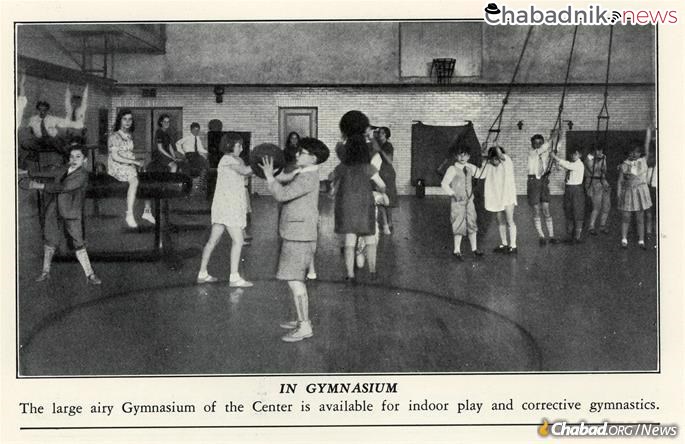
No longer poor immigrants, the Jews of Crown Heights were now American Jews climbing the ladder of success and eager to show that they had arrived. Symbolic was the 1922 dedication of the massive Brooklyn Jewish Center on Eastern Parkway, the first “shul with a pool,” which counted the who’s who of Jewish society among its members. Richard Tucker served as a cantor there, and Marcus Rothkowitz (aka, Mark Rothko) was its art director for more than two decades; guests would include Albert Einstein and Eleanor Roosevelt. The Jewish Center would be among dozens of synagogue edifices constructed in Crown Heights, from the becolumned Chovevei Torah a few blocks down the parkway to the single-family homes converted into shtiebels.
When news got round Crown Heights that Rabbi Yosef Yitzchak was planning on joining them and settling in their genteel neighborhood, not everyone was happy. They were not convinced that their clean, safe and elegant streets needed throngs of Chassidim settling near a Chassidic Rebbe arriving from the Old World. The opposition dissipated after the Sixth Rebbe’s arrival in Crown Heights, as local Jews recognized his saintliness and stature. A year later, in the summer of 1941, the Sixth Rebbe was joined in Crown Heights by his daughter, Rebbetzin Chaya Mushka, and son-in-law, the future Rebbe.
Unbeknown to local Jews, the source of their erstwhile fears would be the key to the community’s ultimate survival.
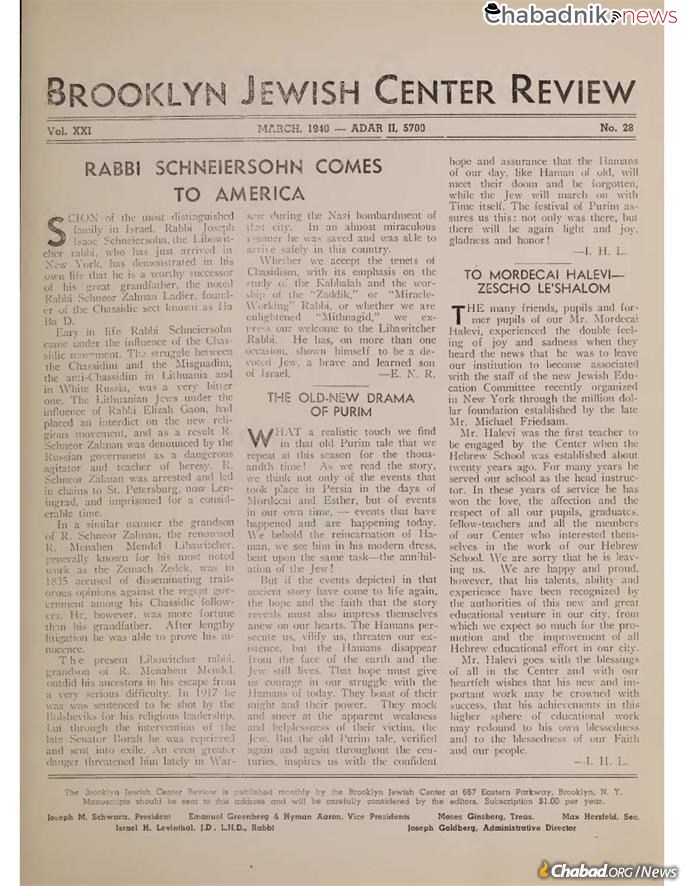
American Judaism
In the early 1950s, Polish immigrant Benjamin (Ben) and American-born Shirley Himber purchased a grocery store on the corner of Lefferts Boulevard and Albany Avenue in Crown Heights. At first, they commuted to the store from Brooklyn’s Williamsburg before eventually moving into a spacious apartment on the same corner in Crown Heights.
“Crown Heights at the time was a mixed neighborhood, not totally religious and not even totally Jewish,” recalls their son, David Himber. Ben Himber had even been warned by a friend that if he insisted on closing his store on Shabbat, he would not be in business for long. But the Himbers persisted, and over the next 15 or so years their store was able to provide comfortably for the family.
Himber’s world in Crown Heights was a safe and familial one, a unique brand of American modern Orthodoxy. He went to school at the Yeshiva of Eastern Parkway, and on Shabbat mostly prayed at the Reines yeshivah on Troy Avenue or the impressive Young Israel of Eastern Parkway. “In Young Israel, basically the only person who wore a black hat was the rabbi,” remembers Himber. “It was packed with a few hundred people; if you came late, you wouldn’t have a seat.” He would also at times attend the youth minyan and Shabbat afternoon groups held in the Agudas Yisrael synagogue on Crown Street.
Avraham Moshe Deitsch moved to Crown Heights with his parents and siblings as a young child in the summer of 1956. Lubavitcher refugees from the Soviet Union, Deitsch’s parents bought a sturdy home on Crown Street, where most of their neighbors were second- and third-generation American Jews. In warmer weather, Deitsch remembers this older generation sitting on their recessed porches and playing cards throughout the weekend.
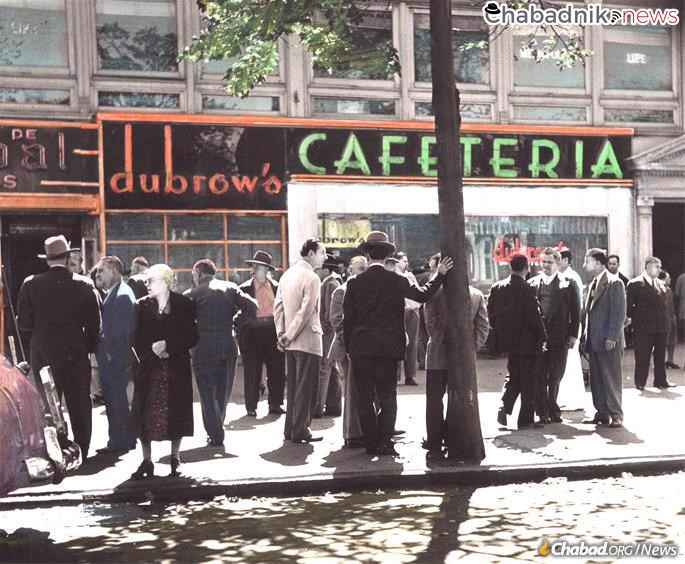
While Lubavitch was the first Chassidic group to join the Jews of Crown Heights, they were not alone. Among others, in the post-war years the Novominsker, Sadigura and Bostoner Rebbes established courts in Crown Heights. So did the Skulener Rebbe, Rabbi Eliezer Zusia Portugal, following his 1960 release from prison in Communist Romania (an operation in which the Rebbe played a crucial role.) After spending time on Manhattan’s West Side, the Bobover Rebbe, Rabbi Shlomo Halberstam, moved to Brooklyn Avenue, north of Eastern Parkway, and opened a synagogue and yeshivah. With the influx of Chassidic Rebbes came a large number of Polish and Hungarian Holocaust survivors, traditional European Jews who prayed with their respective rebbes or opened shtiebels of their own.
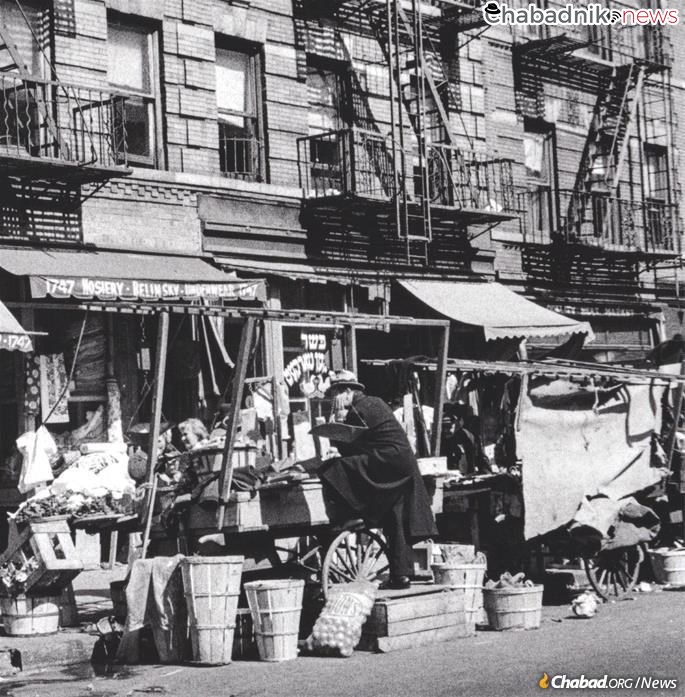
“On Shabbat day, we would walk to 770 to [pray] with the Rebbe,” recalls Deitsch. “But there were a few shuls on our block, and Friday nights and Shabbat afternoon we’d often pray at the Novominsker shul on the corner of Crown and Schenectady. I remember very clearly these survivors rolling up their sleeves and showing me the numbers tattooed on their arms.”
The Rebbe’s world stature made him the most prominent Jewish leader in the neighborhood, as did his father-in-law’s before him, and each year on Rosh Hashanah, throngs of Jews would come out to Eastern Parkway to watch the Lubavitch procession. With the Rebbe at the helm, hundreds of local Chassidim and guests from abroad would march down the parkway to the lake at the Botanical Gardens to perform the tashlich ceremony, all while singing and spreading the holiday cheer.
“ … I saw [the Rebbe] every year, for yuntif, because I lived across the street from the Botanic Gardens,” remembered the late Ida Ostrow, a longtime Crown Heights resident and member of the Brooklyn Jewish Center. “And he used to march down Eastern Parkway with a whole retinue of young men, and they used to elbow their ways, they wanted to get closer [to observe him].” One year, when it was raining heavily, Ostrow recalled debating with her husband whether the Rebbe and Chassidim would still come out despite the weather. She won the argument; they showed up right on schedule.
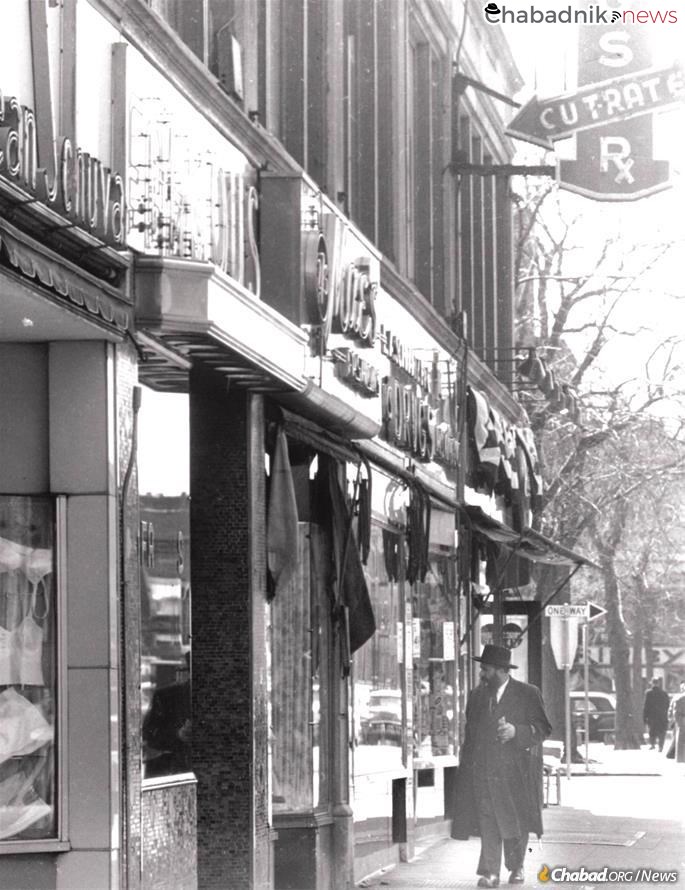
Himber’s first real interaction with Lubavitchers came through Rabbi Zalman and Chava Gurary, customers at his parents’ store, Ben’s Superette, who lived down the block. When the Himbers first moved from Williamsburg, Shirley wore pants, not unusual for Modern Orthodox women, especially of the era. Once, Rebbetzin Gurary came in and gently suggested to Shirley that if she wore a skirt and donned a sheitel, perhaps the store would get more religious customers.
“I don’t know if it got them more customers,” Himber says with a laugh, “but my mother changed her dress code then and never turned back.”
During the summer breaks from yeshivah, Himber’s parents couldn’t afford to send him to camp, and he would mostly help out in the grocery store or play handball with friends in Lefferts Park. One summer, likely around 1958, Rebbetzin Gurary suggested to Himber’s parents that they send David to serve as a waiter at Chabad’s Gan Israel, the overnight camp the Rebbe had founded in the Catskills a year earlier. They liked the idea, and he did, too, so off he went.
“That year, the Rebbe came to visit camp, which was obviously a big event, and more rare than I realized at the time,” says Himber. The next summer he went back as a member of the kitchen staff.
“After those summer, I started going to 770 for the Rebbe’s monthly farbrengen gatherings,” says Himber. The highlight of these visits would be Simchat Torah at 770, where the Rebbe’s hakafot dancing would go deep into the night. One year, as the clock hit 5a.m., he was lucky enough to hear the Rebbe teach a new Chassidic nigun to the gathered.
“This became a very important part of my life,” says Himber, who would later spend decades in various positions in Jewish education, including as the longtime dean of students at Yeshiva University.
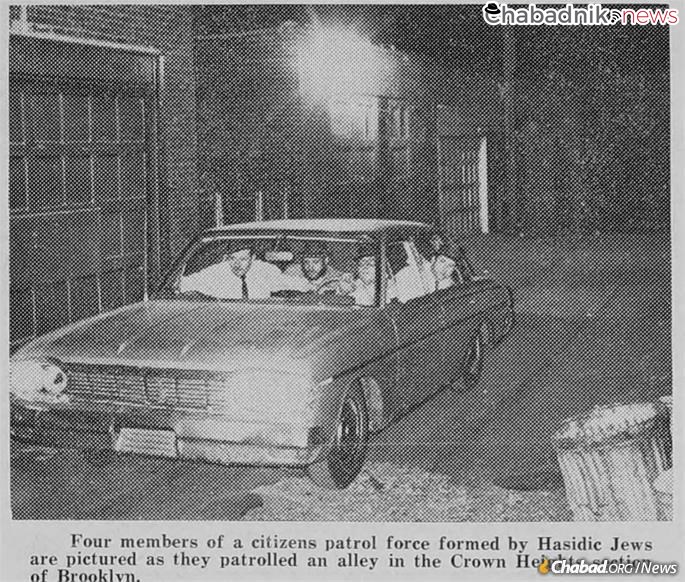
Self Defense
But the peace and tranquility of life in Crown Heights would not last.
One factor in the vast changes that would come over the American City was the migration of Southern blacks to industrial cities in the north, which began during World War I and accelerated after World War II. Southern institutionalized racism in the form of segregation and other infringements on basic human rights, compounded by the lack of economic opportunities for blacks, made the trek up north the better of the two options. Overwhelmingly poor, they still faced discrimination and often lacked access to basic amenities many other groups had; city authorities tended to focus less resources on these neighborhoods, and many turned into ghettos and slums. In the case of New York City, blacks first moved into the tenements of Manhattan’s Harlem, and then into Brooklyn’s Bedford-Stuyvesant and Queens’s South Jamaica.
“In the 1960s, you saw the growth of a very generous social services infrastructure that, while designed to assist people, predicated all kinds of social dysfunction,” says Seth Barron, a New York urban-policy expert who is the author of The Last Days of New York. “There was, for example, a notorious federal program that provided residents of Section 8 apartments priority for new apartments if they were burned out of theirs, and cash for resettlement.”
Public housing, which was designed to be regular apartments that were more affordable for the working class because of the lack of a landlord, had initially demanded levels of upkeep from residents. When these requirements were canceled in the early 1960s, “public housing went to hell,” says Barron.
The huge growth in public housing projects built in Brownsville, which had been a massive, albeit poor and cramped Jewish neighborhood for some 80 years, meant that its Jews began abandoning it in the 1950s. Jews, historically progressive, had actually been the most open to renting and selling housing to their new black neighbors, but the breakdown in social policy, and crucially, the disappearance of community-based policing, meant that their old neighborhood quickly became one of New York’s most dangerous.
“Brownsville ended up being very much a victim of public housing,” says Husock. It was not only the buildings’ existence but their towering, inhuman scale and design, which often cut them off from the neighborhood streets around them and often helped turn them into lawless sub-ghettos of their own. “Brownsville was basically ‘urban-renewaled’ out of existence.”
Rabbi Shloma Zarchi, a Chassidic mentor at the Central Lubavitcher Yeshiva in Crown Heights, grew up during Brownsville’s precipitous decline. While in elementary school in the late 1950s, he’d ride the subway to the Lubavitcher yeshivah’s location on the corner of Bedford and Dean streets on the border of Bedford-Stuyvesant (Bed-Stuy) and Crown Heights.
“I would take the subway home to either the Saratoga or Rockaway stop, and I got beaten regularly,” he recalls. “I had to walk around Betsy Head Park because cutting through it was way too dangerous. I dreaded the changing of the clocks in the winter because it meant I had to walk out of the subway and home through the dark.”
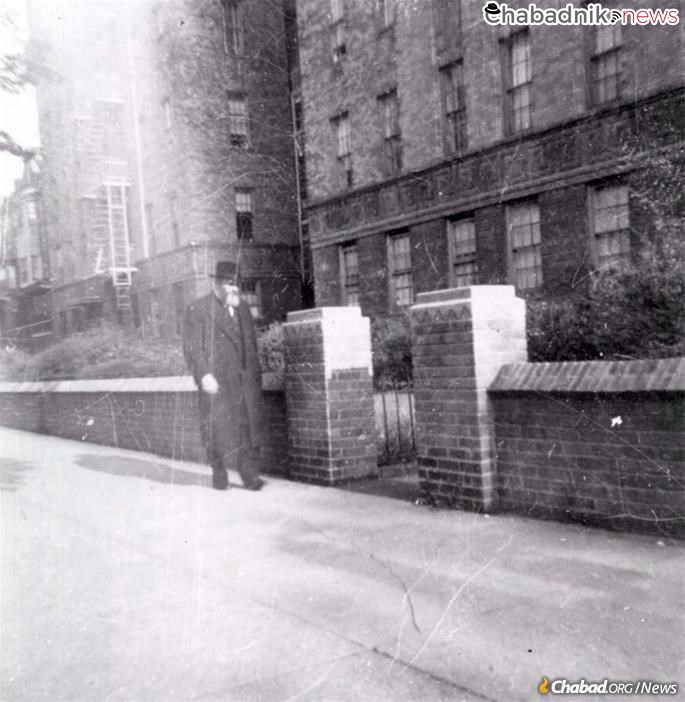
The Jewish infrastructure in Brownsville swiftly disintegrated. From about 80 synagogues still functioning in 1960, by 1965, the neighborhood was down to about eight. This was punctuated by the Hebrew Educational Society’s 1965 relocation to Canarsie; while about 2,000 to 3,000 Jews remained living in Brownsville into the early 1980s, they were almost all too old and too poor to follow their brethren out, and spent most of their time as prisoners in their own homes, too scared to as much as open their doors for food deliveries. Zarchi recalls that when his family moved to Crown Heights in 1960, they were among the last families he knew to leave Brownsville.
But the yeshivah on Bedford and Dean was quickly becoming a target as well. In April of 1964 some 50 black boys and girls attacked the elementary-aged yeshivah students with sticks, garbage-can covers, bicycle chains and switchblades—not the first attack but this time garnering a lot of press in New York. As The New York Times reported on April 28, 1964, the yeshivah’s administrator, Rabbi Samuel (Shmuel) Schrage, chose to have the charges dropped and, instead, the presiding Family Court judge gave the young people a lecture on tolerance. After the hearing, Schrage met with parents outside, telling the Times he was pleased by both their reaction and that of local black community leaders.
Despite such efforts, Bed-Stuy and Brownsville continued to get more dangerous, and violent crimes began spilling into Crown Heights, which was sandwiched in between them.
“Shortly after that [episode in Bed-Stuy] … this [Jewish mother in Crown Heights] had her children playing outside, she left the door open and someone walked in and tried to attack her with a knife,” Schrage’s widow, Rose Schrage, would recall in an interview with Jewish Educational Media’s My Encounter with the Rebbe oral history project. “The community was in an uproar, so naturally, my husband was asked to go to the mayor to get police protection … . The mayor said if we give you police, we have to give everybody else and we don’t have enough men, so no, you can’t have police.”
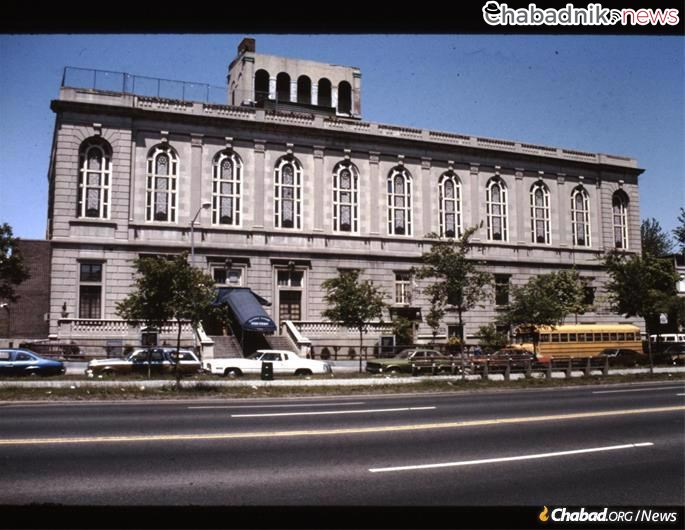
With shop owners scared to open early, citizens afraid to stay out after dark and the police shirking their responsibility, Schrage decided to take matters into his own hands by starting a community crime-patrol group. Armed with just four cars and radios, the Maccabees—as the press would quickly dub them—patrolled the streets and escorted people home at night. It appears they were the first community defense group in the country, and its presence had an immediate effect on the neighborhood. Though many opponents, especially in the beginning, accused Schrage and his group of vigilantism, as crime continued to grow people began recognizing the need. Just a week after the Maccabees launched, 38-year-old Jewish teacher Charlotte Lipsik was raped and murdered in the elevator of her apartment building on Montgomery Street. The horrific nature of the crime shocked the broader community, quickly giving way, as the Times reported, “to frustration, despair and fear.”
“If ever the Hasidic Jews … justified the need for their Maccabee patrol,” one neighbor told the Times, “this proved it. And what is more, we need such patrols on every block in Crown Heights.”
Schrage went out of his way to make clear that this was a question of crime, and not race or religion, dismissing racial insinuations by saying that “crime is color blind.” He also enlisted local Christian ministers to man the radio patrol on Shabbat, and Maccabee volunteers included non-Jewish whites and blacks who were likewise frustrated by the out-of-control violence. “I don’t even live in this neighborhood,” a 31-year-old black volunteer named Willie Johnson told The Saturday Evening Post in the summer of 1964, “but I work here and have friends here. My 15-year-old brother was once stabbed to death by a bunch of kids. It was a terrible and senseless thing. Maybe I can save someone else’s life.”
“I say you cannot solve a problem by ignoring it,” Schrage said in the same Saturday Evening Post piece. “ … [N]ow they also want us to go patrol in Brownsville and Flushing and Coney Island and Flatbush. I can’t become chief of police of the whole city.”
With natural charm and a flair for public relations, Schrage became a Mr. Crime Fighter-type figure, well known in New York. Though he happily ignored or deflected criticism coming from the outside, he was shaken when he started hearing complaints from local members of the Jewish community that his crime-fighting tactics were drawing negative attention to Crown Heights and bringing their property values down.
“My husband went to the Rebbe and he said … I can take the criticism from the outside, but when it’s my own people … that hurts and I really would like to disband,” Rose would tell JEM. “And the Rebbe said to him, don’t disband … make it stronger.”
Four years later, New York Sen. Robert F. Kennedy would cite Schrage’s work combating crime as exemplary. “Citizen patrols have worked in far more dangerous communities,” he told citizens in a public hearing on Long Island. “In Crown Heights, the ‘Maccabee’ patrol substantially cut down violent crime.’ ”
Schrage would remain active in public life, including working in the Lindsay administration, until his untimely passing on Dec. 31, 1976, just shy of his 41st birthday. After her husband suffered a heart attack, Rose called 911, but the New York City paramedics who took the call came late and apparently under the influence of drugs or alcohol. Schrage passed away on the way to the hospital, a preventable death in a city that had lost its way. As a result of his death, Rose spearheaded a campaign to purchase the first-ever ambulance for Crown Heights’ nascent Hatzalah volunteer emergency medical-services organization, so that no one again would have to needlessly die because of the city’s bright-eyed incompetence.
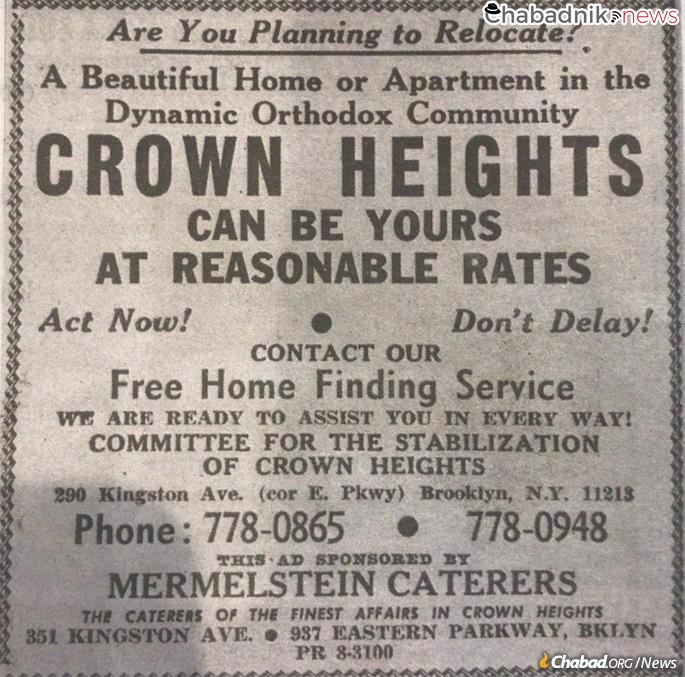
Neighborhood Collapse
Despite the best efforts of people like Schrage, crime continued to rise, and though slowly at first, the makeup of the neighborhood was changing. Like other urban areas around the country, the drip soon turned into a flood. As white residents of Crown Heights began moving out, the “city began to place families on public assistance in the older buildings where vacancies were frequent, encouraging landlords’ acceptance by offering incentive payments,” wrote the late Indiana University anthropologist Jerome Mintz in Hasidic People. “As the poorer tenants moved in, the departure of the older tenants was accelerated.”
In addition to blacks from Bed-Stuy, after 1965 came a big influx of immigrants from the West Indies, and by 1969, the West Indian Day Parade was already being held on Eastern Parkway.
That’s when Jews began selling their homes, predicting they would soon drop in value. Himber recalls a neighboring Jewish family selling the first house on Lefferts and disappearing overnight. Before long, the majority of the block had flipped from white and Jewish to black and not. “There was hysteria,” he recalls. His parents had some time earlier purchased a home, and between that and their store, felt invested in the neighborhood. But around 1968-69, the second time they got held up at gunpoint, they decided it was time to go.
“My mother told my father that no matter what, she is not walking back into that store,” says Himber. “They tried selling their home to a Jewish family but couldn’t find one. They sold whatever goods were left in the store, closed it and moved to Canarsie.”
During this time, Crown Heights became ground zero for blockbusting in New York City. The practice, in which unscrupulous real estate brokers and agents would use a variety of tactics, including threats and intimidation, to convince a homeowner to sell at a low price got so bad that in 1969, New York State began investigating all sales of one- and two-family homes in Crown Heights and neighboring East Flatbush. At the same time, the blockbusters were taking advantage of Federal Housing Authority-insured mortgages to resell properties to unqualified buyers at a significant profit.
Beachhead
The Rebbe did not mince words that Passover of 1969.
“A phenomenon has recently spread among the Jewish people, like a plague, G‑d forbid, of abandoning Jewish neighborhoods,” the Rebbe stated. Not only are they selling off their homes, but this abandonment “includes the sale of synagogues and study halls, and, by extension, is causing damage or even destruction of the livelihood of many of their brethren.”
Over the course of the talk, the Rebbe weaved together Torah sources to state clearly that it was against Jewish law to leave a Jewish neighborhood when it was explicitly under attack, and that each individual home sold was adding to the clear and present danger to human life. Moreover, the Rebbe noted, the danger began when it was still just a rumor, quickly becoming a self-fulfilling prophecy. He also noted that the closure of synagogues and schools was causing both material and psychological damage to those who remained and needed these central elements of Jewish life. The Rebbe also focused attention on the poor, elderly and infirm who could not be forsaken—as proved to be the case in places like Brownsville.
“The only way to avoid the damage of what has already been done,” he stated, “is to stabilize and expand this neighborhood.” Through this, the Jewish people would be strengthened—not only in Crown Heights but in Williamsburg, Borough Park and Washington Heights; Baltimore, Chicago, Detroit, Pittsburgh and Washington; Melbourne and London; and throughout the length and breadth of the land of Israel. “In our age the world is four cubits by four cubits,” the Rebbe emphasized, citing a Talmudic dictum to convey how small the world was. “ … An action here impacts other places, especially since the entire Jewish people is one entity.”
The Rebbe edited this talk, and it was published in the HaPardes rabbinic journal and widely distributed. The following issue of the journal included a letter from Rabbi Moshe Feinstein, the leading halachic arbiter of the 20th century, supporting the Rebbe’s stand in the strongest terms. “Had [the Rebbe] not written already on this subject, I would have written almost the same thing on my own. But now that the Rebbe has given his opinion, I can only say that this is the truth and it needs to be publicized.”
The content and urgency of the Rebbe’s talk finally shook the Crown Heights Jewish community out of its complacency and got its community leaders working. Over the next years, the Rebbe would sound the theme more than once—sometimes expressing anguished frustration at the lack of progress, but never once changing his stance by an iota. Instead, the Rebbe would stress the importance of celebrating weddings and other occasions in Crown Heights, both for morale purposes and to provide local vendors with a living, and to shop local to likewise support those who kept their stores in the neighborhood. The Rebbe would also ask that affordable housing be built in the community. In all this, the Rebbe reminded his listeners that his father-in-law had chosen Crown Heights to be his base in the New World and spent the last 10 years of his life there. It was a place of blessing for all of its inhabitants, and would only take commitment to tap into these blessings.
“This is when the [Crown Heights Jewish Community] Council started influencing people not to move, when it started buying houses from people who ran away, and seeing that there should be a balance in the community and it shouldn’t be abandoned,” the late Mendel Shemtov, a former chairman of the CHJCC, told Mintz. “If we knew that someone was running away and wants to sell his house we would buy the house to preserve it and then resell it, most of the time at a loss … . We started fighting that a shul should not be sold to a church. Of the 40 shuls in our community only one was sold to a church. In another community all 40 would have gone.”
“There was a double idea behind saving the shuls,” explains Nochum Pinson, who grew up in Crown Heights and served on the board of the CHJCC in the 1970s and ’80s. “On the simplest level, to make sure the institution doesn’t close and isn’t sold. But it was also psychological. If someone once had a busy shul on their block and then it gets weaker, to the point that they can’t even gather a minyan, it becomes depressing. You lose a shul, you could lose the whole block.”
The emphasis on saving synagogues was such that Lubavitcher yeshivah students and young married men would pray in various community synagogues to keep the quorum intact. This was by no means only done for the synagogues in the immediate area around 770, but in all corners of Crown Heights, including places like Kol Israel, a synagogue on the far outskirts of Jewish Crown Heights that was propped up for decades by Lubavitch yeshivah students.
Over the next years, the CHJCC—whose office was firebombed in 1970—and nonprofit community organizations such as Chevra (Chevra Machzikei HaSchechuna, or Society for Stabilizing the Community) preserved many dozens of homes for the Jewish community. Among the initial and most active backers of this work throughout the 1970s was the aforementioned Rabbi Zalman Gurary. Over time, using funds raised from the community in part by selling shares—the Rebbe purchased a share personally, too, as a resident of Crown Heights—Chevra also managed to purchase and renovate whole apartment buildings on behalf of and for the benefit of the Jewish community. All of this played a part in stabilizing the community, and by the early 1980s, it was clear even to outsiders that the Jews of Crown Heights were not going anywhere.
This commitment did not come without a price; during the 15 years preceding the 1991 riot, at least 10 members of the Crown Heights Jewish community were murdered. This included the 1975 murder of Holocaust survivor Israel Turner, shot as his wife watched out the window of their apartment after he told his would-be mugger that he wasn’t carrying any money on the Sukkot holiday. His funeral was interrupted by shouts of “Heil Hitler” and “Hitler was right.”
A neighbor told the Times that Turner’s wife remained composed, even though she had seen her husband murdered in front of her. “She told me that she and her husband had been inmates in the Auschwitz concentration camp, had seen members of their family tortured and had learned to have strength for things like this.”
Two years later, Avraham Eliezer Goldman, a teenage yeshivah student, was stabbed to death while making a payphone call. Two years after that, in 1979, Rabbi Dovid Okunev, a recent Lubavitcher immigrant from the Soviet Union, was murdered on his way to morning prayers.
Place of Blessing
As Crown Heights became a majority non-Jewish and crime-ridden neighborhood, some questioned why the Lubavitchers insisted on staying there. “That was the undertone—what do they have with Crown Heights?” recalls Pinson. “Let them go somewhere else, to the suburbs, anywhere else. There’ll be less racial friction, life will be better for everyone—they didn’t understand why we cared so much.”
“We could have fled and been outspoken liberals like the holy men in the synagogues of Westchester,” Schrage told the Times in 1970. “But Rabbi Schneerson emphasizes that this would be a sin against our fellow man.”
“The Rebbe’s proclamation is obviously what kept this nucleus there that then exploded in growth,” observes Barron. “What he did in Crown Heights is remarkable.”
From the vantage point of today, Pinson says it’s clear that beyond sending a clear message that Jews do not have to run, the Rebbe’s stand was crucial to the survival not only of Crown Heights but of the Jewish neighborhoods of Flatbush and Borough Park, among others, as well. “There’s no way they would have held if we would have folded,” states Pinson.
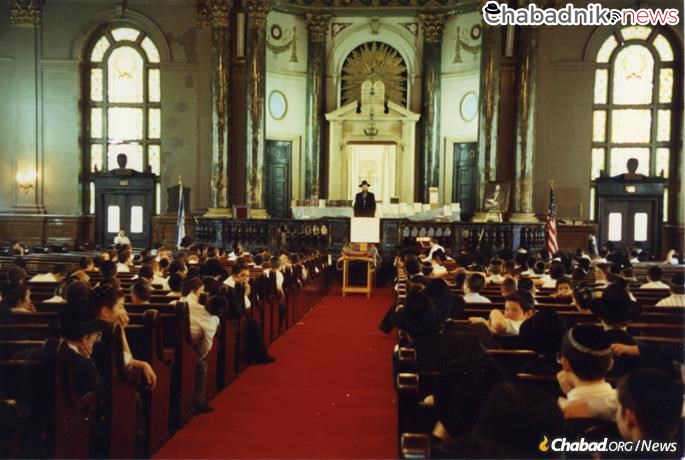
A poignant example of Crown Heights’ transformation and ultimate survival as a Jewish community is the fate of the Brooklyn Jewish Center. The Oholei Torah boys yeshivah began renting the building in 1972, and 10 years later, the Brooklyn Jewish Center’s Rabbi Emeritus Israel Levinthal, Rabbi Benjamin Kreitman and the board of trustees rejected an offer for $6 million from a church and instead sold it to the Chabad yeshivah for a tenth of the price.
“My grandfather died the same year the Center was sold to Oholei Torah. I don’t think that was a coincidence,” Levinthal’s granddaughter, Anne Levinthal, wrote in a testimonial for a Brooklyn Jewish Center reunion event. “He had spent years of anxious worry over the future of the Brooklyn Jewish Center. I believe that he died in 1982 not only because, at 94, he had many physical infirmities. After the sale of the Center, the rabbi allowed himself, at long last, to release his tenacious grip on his earthly life, knowing that his beloved Brooklyn Jewish Center, to which he had given his heart, his soul and his life, had safely been transferred into the devoted and caring hands of Chabad.”
“There would be times when I’d see Benjamin Moskowitz, the former president of the Jewish Center, just show up, and I’d ask him, ‘Ben, what are you doing here?’ ” says Rabbi Nosson Blumes, Oholei Torah’s director of development. “And he’d say, ‘I just want to see the yiddishe kinderlach [Jewish children] go to lunch,’ and he’d just watch them and cry. How many American Jews can go back to the community which their parents or grandparents built and invested in, and find thriving Jewish life today?”
They can in Crown Heights, a place whose history lives on, where the past is intertwined with the present and the future. It is so because a group of hardy Jews listened to the words of a Jewish sage, sank their roots into the earth, supported their brethren individually and communally, materially and spiritually, and by doing so merited to live in a neighborhood where, as the Rebbe pronounced on more than one occasion: Kan tzivah Hashem es habracha—“This is where G‑d commanded His blessing.”
